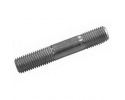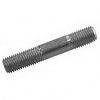Description
DIN 939 STUD METAL END
Metric double end studs are NOT called out by their overall length.
To calculate the overall length of a metric double end stud, add the tap end thread length (L2) to the
called out length [nut thread end length (L1) + the unthreaded portion]. OAL = L2 + L
Some general guidelines for calculating the length of L2 are:
Some general guidelines for calculating the length of L1 are:
d1 (nominal diameter in mm) x multiplier. Example: for a DIN 939 stud where d1 = M12 (M12x1.75,
but the pitch is not used the length calculation) x (DIN 939 multiplier) 1.25 = (L2) 15 mm
Studs whose (L) dimension is less than or equal to 2 times their nominal diameter + 6 mm,
will normally be fully threaded.
For studs whose (L) dimension is greater than or equal to 2 times their nominal diameter + 6 mm,
but not longer than 125 mm, the L1 dimension = 2 times the nominal diameter + 6 mm.
For studs whose (L) dimension is greater than or equal to 125 mm but less than 200 mm, the
L1 dimension = 2 times the nominal diameter + 12 mm.
For studs whose (L) dimension is greater than or equal to 200 mm, the L1 dimension = 2 times
the nominal diameter + 25 mm.
The tap end thread of a double end stud is normally to an Sk6 thread tolerance which is an
interference fit. Please specify whether you want normal fit or interference fit. To specify a stud
with normal thread fit on the tap end, add the suffix FO (example: DIN 939FO).


Reviews
There are no reviews yet.